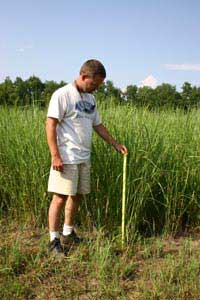|
June 28, 2006
Submitted by Patricia McDaniels
UT Institute of Agriculture Marketing and Communications
|
 |
|
Chad
Hicks, of the UT Research and Education Center at Milan,
evaluates the progress of a switchgrass plot. |
Much is being said of the
potential to exchange crops for gas, or more specifically to
convert biomass into energy and biobased products. Ethanol and
biodiesel are on the minds of producers, politicians, and
consumers alike.
While ethanol is currently produced largely from corn, future
predictions are that ethanol will be produced from wood and
dedicated energy crops like switchgrass. Research by two
economists with the
University of Tennessee, Daniel G. De La Torre Ugarte and
Burton C. English, indicates that the Mid South – in particular
Tennessee – could play a huge role in meeting federally
established renewable energy goals through the production of
dedicated energy crops such as switchgrass.
Switchgrass is laden with potential energy. The native grass is
a perennial that produces large yields that can be converted
into energy by co-firing and through distillation into ethanol.
Of all the high-yielding grasses, switchgrass is the most viable
species for widespread use as a biomass crop in the United
States.
The two researchers will present the details of their study at
the 24th Milan No-Till Field Day sponsored by the University of
Tennessee Agricultural Experiment Station on July 27 in Milan,
Tennessee.
"We have the opportunity to lead the nation in the production of
dedicated energy crops such as switchgrass," said English. The
economist also maintains that producing dedicated energy crops
will increase Tennessee and regional farm income and reduce soil
erosion if done correctly.
Despite the extensive yield analyses, region-specific
recommendations for the production of switchgrass are lacking.
"Specifically," says Don Tyler, a professor of soil science with
the University of Tennessee, "recommendations for Tennessee and
Mid South soils and climate relative to seeding rate, nitrogen
fertilization, and weed control were lacking."
Tyler and his associate Chris Walker with UT's Department of
Plant Sciences, have spent the last several growing seasons
measuring and comparing production data for switchgrass. The two
will also discuss their findings to date at the Milan No-Till
Field Day on July 27th.
"The lowland 'Alamo' variety of switchgrass has been naturally
selected as the most suitable commercially available cultivar,"
said Tyler. "We compared Alamo with three selected cultivars,
two from Georgia and one from Oklahoma. All three were more
vigorous in growth habit as compared to Alamo and were higher
yielding than Alamo on some of the four soil-landscape positions
studied," he said.
Tyler and Walker also studied the interaction between seeding
rate and nitrogen fertilizer rate. The effect of nitrogen and
seeding rates varied across sites but on the most productive
sites, the lower seeding and fertilizer rates were sufficient in
the second growing season. Weed competition was one of the
reasons for the low productivity of some sites, Tyler said.
Weed control research has been initiated by Larry Steckel, UT
Extension assistant professor, for both the establishment year
and second growing season, with emphasis on control of very
competitive problem grasses such as broadleaf signalgrass and
crabgrass. Weed control options have been identified but most
are not currently legally labeled for switchgrass.
"If switchgrass becomes a viable alternative crop, we hope to
have effective and economical production strategies developed,"
Tyler said.
Details about these presentations and a complete copy of the
program for the Milan No Till Field Day are available online at
http://milan.tennessee.edu. |